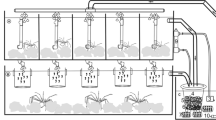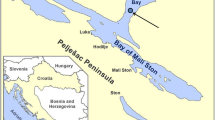Abstract
The morphological characteristics and the cuttlebone formation of Sepia esculenta exposed to different water temperature fluctuations were investigated under laboratory conditions. Temperature fluctuation cycles (15 cycles, 60 d in total) consisted of the following three regimes of 4 d duration: keeping water temperature in 26°C for 3 d (Group A), 2 d (Group B), 0 d (Group C, control); then keeping water temperature in 16°C for the next 1, 2, 4 d. No significant difference in the survival rate was observed between the control and temperature fluctuation groups (P >0.05). Lamellar depositions in a temperature fluctuation cycle were 2.45±0.02 for Group A, 2.00±0.02 for Group B, and 1.78±0.02 for Group C (P< 0.05). The relationship between age and number of lamellas in the cuttlebone of S. esculenta under each water temperature fluctuation could be described as the linear model and the number of lamellas in the cuttlebone did not correspond to actual age. Group A had the highest cuttlebone growth index (CGI), the lowest locular index (LI), and inter-streak distances comparing with those of control group. However, the number of lamellas and LI or CGI showed a quadratic relationship for each temperature fluctuation group. In addition, temperature fluctuations caused the breakage of cuttlebone dark rings, which was considered a thermal mark. The position of the breakage in the dark rings was random. This thermal mark can be used as supplementary information for marking and releasing techniques.
Similar content being viewed by others
References
Aldanondo N, Cotano U, Etxebeste E, Irigoien X, Álvarez P, Martínes de Murguía A, Herrero D L. 2008. Validation of daily increments deposition in the otoliths of European anchovy larvae (Engraulis encrasicolus L.) reared under different temperature conditions. Fish. Res., 9: 257–264.
Bayne B L. 1983. Physiological ecology of marine molluscan larvae. In: Wilbue K M ed. The Mollusca. Academic Press, New York. p.299–343.
Bettencourt V, Guerra A. 2001. Age studies based on daily growth increments in statoliths and growth lamellae in cuttlebone of cultured Sepia officinalis. Mar. Biol., 139: 327–334.
Choe S. 1962. The shell and the locular index of the cuttlefishes, Sepia esculenta Hoyle, Sepia esculenta Sasaki, Sepiella maindroni de Rochebrune. Bull. Jpn. Soc. Sci. Fish., 28: 1 082–1 091.
Choe S. 1963. Daily age markings on the shell of cuttlefishes. Nature, 197: 306–307.
Forsythe J W. 1993. A working hypothesis of how seasonal temperature change may impact the field growth of young cephalopods. In: Okutani T, O’Dor R K, Kubodera T eds. Recent Advances in Fisheries Biology. Tokai University Press, Tokyo. p.133–143.
Hao Z L, Zhang X M, Zhang P D. 2007. Biological characteristics and multiplication techniques of Sepia esculenta (Mollusca, Cephalopoda). Chin. J. Ecol., 26(4): 601–606. (in Chinese with English abstract)
Hokanson K E F, Kleiner C F, Thorslund T W. 1977. Effects of constant temperatures and diel temperature fluctuations on specific growth and mortality rates and yield of juvenile rainbow trout, Salmo gairdneri. J. Fish. Res. Board. Can., 34: 639–648.
Hoyle W E. 1886. Report on the Cephalopoda collected by H.M.S. Challenger during the years 1873–76. Rep. Sci. Res. Voy. Chall. Zool., 16: 1–245.
Jereb P, Roper C F E, Vecchione M. 2005. FAO Species Catalogue for Fishery Purposes. In: Jereb P, Roper C F E eds. Cephalopods of the world. Food and Agriculture Organization of the United Nations, Rome. p.1–19.
Le Goff R, Gauvrit E, Pinczon Du Sel G, Daguzan J. 1998. Age group determination by analysis of the cuttlebone of the cuttlefish Sepia officinalis L. in reproduction in the Bay of Biscay. J. Mollus. Stud., 64: 183–193.
Martínez P, Bettencourt V, Guerra Á, Moltschaniwskyj N A. 2000. How temperature influences muscle and cuttlebone growth in juvenile cuttlefish (Sepia elliptica) (Mollusca: Cephalopoda) under conditions of food stress. Can. J. Zool., 78: 1 855–1 861.
Natsukari Y, Hirata S, Washizaki M. 1991. Growth and seasonal change of cuttlebone characters of Sepia esculenta. In: Boucaud-Camou E ed. Proceedings of the First International Symposium on the Cuttlefish Sepia, University of Caen, Caen, June 1991. Centre de publications de l’Université de Caen, Caen, France. p.49–67.
Okutani T. 1995. Cuttlefish and squids of the world in color. National Cooperative Association of Squid Processors, Tokyo. p.43.
Ré P, Narciso L. 1994. Growth and cuttlebone microstructure of juvenile cuttlefish, Sepia officinalis L., under controlled conditions. J. Exp. Mar. Biol. Ecol., 177: 73–78.
Richard A. 1969. The part played by temperature in the rhythm of formation of markings on the shell of the cuttlefish Sepia officinalis L. (Mollusca Cephalopoda). Experientia, 25: 1 051.
Richard A. 1971. Contribution à l’étude expérimental de la croissance et de la maturation sexuelle chez le Céphalopode Sepia officinalis L. (Mollusque, Céphalopode). Thèse Doctorat d’Etat, Université de Lille.
Song Z B, He C L, Fu Z D, Shen D Z. 2008. Otolith thermal marking in larval Chinese sucker, Myxocyprinus asiaticus. Environ. Biol. Fish., 8 2: 1–7.
Song Z B, Fu Z D, He C L, Shen D Z, Yue B S. 2009. Effects of temperature, starvation and photoperiod on otolith increments in larval Chinese sucker, Myxocyprinus asiaticus. Environ. Biol. Fish., 84: 159–171.
Tang X M, Chai B F. 1981. Ultrastructural investigation of experimental fracture healing-IV: electron microscopic observation on transformation and fate of fibroblast and chondrocytes. C h in. Med. J., 94(5): 291–300. (in Chinese with English abstract)
Volk E C, Schroder S L, Grimm J J. 1999. Otolith thermal marking. Fish. Res., 43: 205–219.
Yagi T. 1960. Studies on the identification method of races in Sepia esculenta Hoyle by using the locular index of shells. Bull. Jpn. Soc. Sci. Fish., 26: 640–645.
Zheng X D, Xiao S, Wang Z P, Wang R C. 2007. Histological and histochemical analyses of the cuttlebone sac of the golden cuttlefish Sepia esculenta. J. Ocean. Univ. Chin., 6(4): 393–397.
Author information
Authors and Affiliations
Corresponding author
Additional information
Supported by the National High Technology Research and Development Program of China (863 Program) (No. 2010AA10A404), the National Marine Public Welfare Research Project (No. 200805069), and the NMOE Project (No. 1011010603)
Rights and permissions
About this article
Cite this article
Lei, S., Zhang, X., Liu, S. et al. Effects of temperature fluctuations on cuttlebone formation of cuttlefish Sepia esculenta . Chin. J. Ocean. Limnol. 30, 547–553 (2012). https://doi.org/10.1007/s00343-012-1221-9
Received:
Accepted:
Published:
Issue Date:
DOI: https://doi.org/10.1007/s00343-012-1221-9




